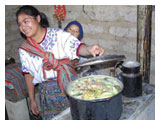Crispin Pemberton-Pigott (New Dawn Engineering) with Prof Sereeter Lodoysamba (National University of Mongolia),
Sod Dulam (Energy consultant, Ulaanbaatar) and Altangadas Tsegmid (Heat and Power Systems consultant, MonEnergy)
http://www.youtube.com/watch?v=-6sGCyNHvQ4
This stove was seen in operation in 6 and 8th March 2010 by in the home of Demberel in Ulaanbaatar, Mongolia.
It is a form of top lit updraft (TLUD) stove part of the time. The combustion chamber is a (ceramic?) lined square box with a grate enclosing the top and the bottom. It is mounted in a fairly standard brick-lined steel box with a heat exchanger at the back. The overall dimensions are approximately 500 W x 600 L x 500 H.
The unusual burning sequence is:
- Open the stove, push the top grate out of the way (towards the back).
- Build a wood fire in the combustion chamber and wait until it has burned to the point of being substantially charred.
- Load coal on top of the burning wood. At this point it becomes a bottom lit, updraft (BLUD) burner.
- The coal is left to be heated on top of the burning/smouldering wood. The top grate is pulled over the coal closing the box. It is now a square box with a grate on the top and bottom.
- When flames emerge through the coal and appear above the top grate, the box is flipped over using the handle on the front of the stove. At this point it becomes a TLULD burner because the charcoal has been moved to the top. The smoke arising from the hot coal below has to pass through the charcoaled wood on top and is ignited.
- The charcoal finishes burning during which time the coal gets fully ignited, de-volatilised and coked. After that it is an ordinary coke fire.
The coke fire burns until it expires. During the first visit it was tested with a combustion analyser during the later portion of a burn. There was nothing unusual about the fire. On the second visit gas samples were taken during ignition and for a period of one hour afterwards. The sample point was where the gases leave the mass wall and enter the bottom of the short chimney passing through the roof. Gases were analysed with a certified TSI CA-6203 combustion analyser.
Initially the CO/CO2 ratio was 20% to 40% as the fire got going. The ratio after one hour was just over 4% and 12 % late in the fire. At all times there was a high excess air ratio, 900% on high power and 1500% on low. This is higher than a traditional stove which runs 400-1000%.
The system efficiency was negatively affected by the high excess air level: from 40 to 50%. The system efficiency of a traditional stove is about 70%. The major portion of the particulates are emitted during the first 45 minutes in both stoves.
The 'heating wall' is a heat storing brick structure that condenses the combustion and fuel moisture thereby retaining the latent heat of condensation. They are gaining popularity. In spite of condensing the moisture and the low gas exit temperature (70-90 Deg C) the system efficiency is not high because of the great quantity of warmed air passing through the system. The openings are large and the stove is generally leaky, for example the cast iron top on the one we tested is not bolted onto the body (see the picture near the end of the video).
A moveable flat plate with a few holes in it is provided over the top grate that limits the rate of combustion. The burn rate is quite high for a domestic stove (because of the large area of the grate). It is probably able to reach 40 kW thermal output. The flat plate is pulled over the top grate and interferes with the airflow, extending the burn. A full charge of coal will reportedly burn for 8 hours in that condition and still have some hot coals left with which the next fire can be started. That is a major consumer demand - burning through the night.
Observations
: It is likely that this system will reduce start-up emissions from the point that the hot coal is under the burning wood/charcoal fire (the TLUD stage), for approximately 1/2 of the ignition cycle.
: The system efficiency is low compared with a traditional stove which means that although the rate of particulate production may be less per kg burned during part of the ignition cycle, more coal might have to be burned to provide adequate heat, possibly increasing the overall production of smoke.
The contact information for one of the local (Mongolian) promoters is:
Prof Adiyasuren Borjigdkhan ozoff@magicnet.mn
He reports that they wish to install 80 in homes around Ulaanbaatar to gather user opinions.
Submitted by
Crispin Pemberton-Pigott (New Dawn Engineering)
with Prof Sereeter Lodoysamba (National University of Mongolia)
and Sod Dulam (Energy consultant, Ulaanbaatar)
and Altangadas Tsegmid (Heat and Power Systems consultant, MonEnergy)
12 March 2010
